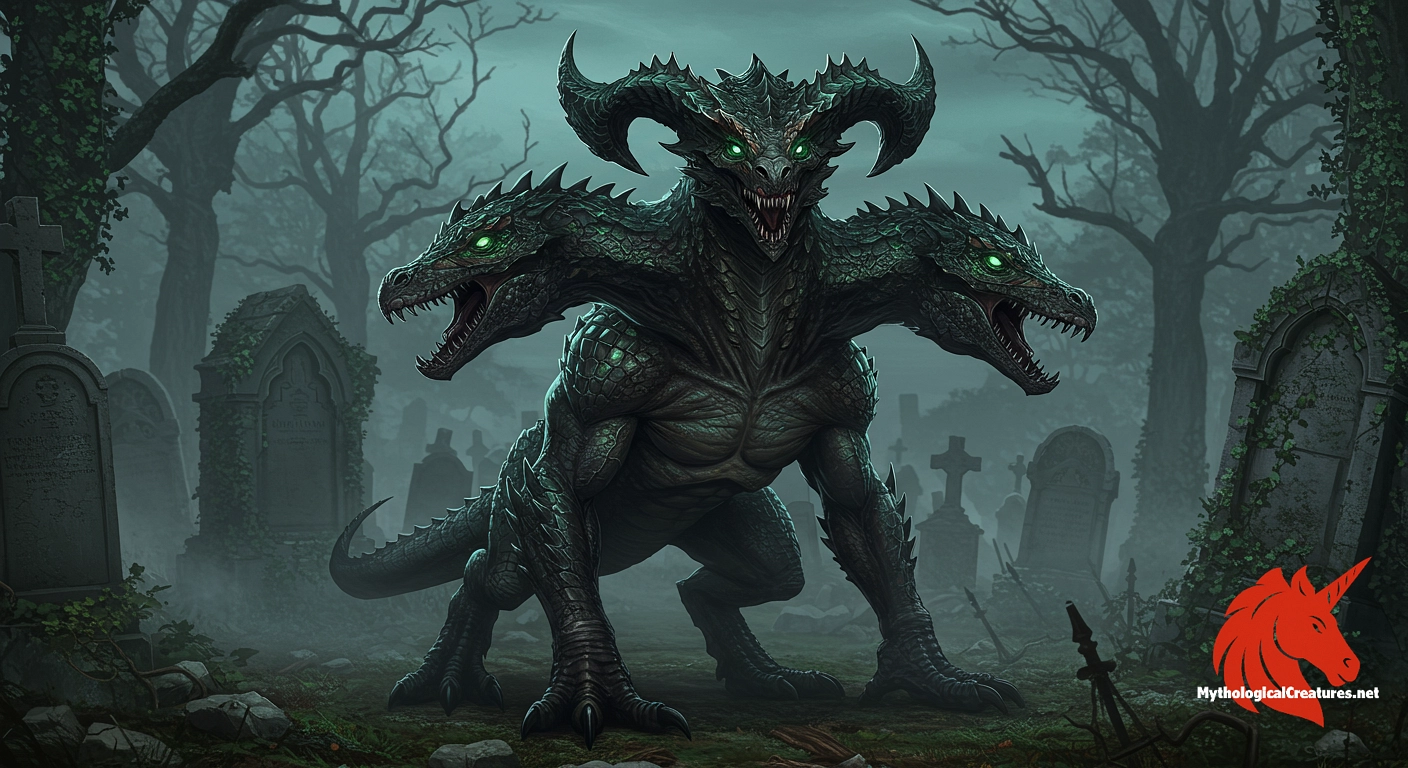Bune: Bune is a demon duke from Western occult grimoires known for his three-headed dragon form and necromantic powers.

Bune
Bune - Represents the mysterious and potent forces of demonic necromancy and wealth bestowal in occult traditions
Origins & First Encounters
Bune is a formidable demonic duke whose legacy stretches back to the complex world of medieval occult manuscripts while echoing influences from even older mythic traditions. His presence is recorded in grimoires that reflect a time when supernatural hierarchies were meticulously catalogued and feared. First attested in texts like the Lesser Key of Solomon and later expanded in additional works, his identity was forged amid debates over the control of spiritual forces. Emerging from a cultural context that sought to explain the mysteries of life, death, and the afterlife, Bune’s character simultaneously embodies allure and dread. His reputed ability to manipulate the dead and to grant wealth underscores a fascination with the limits of human ambition and mortality. The blending of fearsome power with an enigmatic charm made him a subject of both reverence and caution. His story has become emblematic of the era’s entanglement with both divine ambition and occult secrecy. In the tapestry of demonological lore, Bune represents the intersection of the ancient, the occult, and the enduring human quest for hidden knowledge. His myth continues to provoke intrigue as a symbol of power that transcends simple categorisation.
Source Texts & Tale Variants
Bune’s narrative is based on an eclectic range of primary sources that have cemented his status within the demonological canon. The Lesser Key of Solomon, especially in Thomas Rudd’s version where he is named Bime, provides one of the earliest and most detailed attestations of his character. Johann Weyer's Pseudomonarchia Daemonum systematises his role and influence within the diabolical hierarchy. In the Dictionnaire Infernal, Jacques Collin de Plancy delivers an account that mixes both vivid imagery and a catalogue of his supernatural attributes. The Livre des Esperitz further diverges by ascribing him command over 35 legions of spirits, a contrast to the more common figure of 30 legions noted elsewhere. Each source not only confirms his status as a mighty duke but also contributes unique details regarding his abilities and mythos. Variants in his story reveal a nuanced interplay between his roles as a mover of the dead, a bestower of riches, and a fountain of enigmatic wisdom. Modern occult writers and researchers have continued to scrutinise these texts, ensuring that his legend is both preserved and open to reinterpretation. The multiplicity of accounts makes Bune a fascinating study in the evolution of mystical narrative.
Form & Powers
Bune is vividly portrayed with an appearance that defies conventional boundaries between the human and the monstrous. His depiction as a three-headed dragon immediately sets him apart, merging the mythic ferocity of dragons with an unexpected human element. One of his heads distinctly bears human features, exuding an aura of cunning intelligence amidst the reptilian terror. The remaining two heads, resplendent with scaled snouts and fierce expressions, betray the raw power and primal nature of his draconic lineage. Each head is often imagined with sharply contrasting demeanours, contributing to a persona that is at once wise and brutally formidable. Descriptions frequently suggest that his body slithers with serpentine grace while radiating an intense, otherworldly energy. The interplay of human intellect and beastly aggression in his form is designed to unsettle as much as to mesmerise. Variations in artistic renditions sometimes include additional details such as horns or elongated, lashing tails that enhance his mythic presence. Overall, his amalgamated features serve as a potent visual metaphor for the dual character of cunning intellect and unbridled savagery.
Regional Faces
The depiction of Bune has not remained static, with nuances emerging as his legend crossed cultural and regional boundaries. While European grimoires typically preserve his identity as a draconic demon duke, local interpretations have sometimes adjusted his image to fit indigenous mystical narratives. In several traditions, his role as a granter of wealth and mover of the dead has been amplified to align with regional folklore about fortune and mortality. In areas with a significant Mesopotamian influence, for instance, there are allusions to serpentine deities, which subtly shift his imagery away from the strict dragon motif. Variations in the number of legions he commands, such as the disparity between 30 and 35 in different texts, further hint at localized adaptations. His character may also incorporate symbolic elements reflective of regional religious practices, blending native beliefs with European demonological frameworks. This geographical malleability illustrates how mythic figures can be recontextualised to resonate with distinct cultural landscapes. The way communities have embraced and reinterpreted Bune is a testament to the dynamic evolution of myth, which adapts to the spiritual and social needs of its audience.
Cultural Parallels
Bune’s multifaceted persona invites comparisons with a variety of mythological figures who embody both wisdom and terror. His triple-headed form can be loosely paralleled with other mythic creatures that represent a triplicity of power, echoing the symbolic significance of triune deities found in several ancient traditions. The integration of human intelligence with draconic might places him in conversation with figures who challenge the boundary between the rational and the bestial. Similar to other demon dukes in classical demonology, his portfolio of powers—ranging from manipulating the dead to bestowing fortune—aligns him with a broader category of entities that serve as intermediaries between worlds. Interpretations of Bune often recall tales of transformational beings, which simultaneously lecture and lure those who seek forbidden wisdom. The careful structuring of his dominion over a set number of legions finds echoes in other mystical hierarchies across diverse cultures. In a comparative sense, his narrative shares affinities with ancient underworld deities whose roles mingle retribution with protection. These intertextual connections enrich our understanding of how ostensibly disparate mythic traditions can converge around similar archetypes. His story, therefore, serves as a conduit for exploring the universal themes of power, duality, and the quest for esoteric mastery.
Legacy & Modern Evolution
The evolution of Bune’s legend mirrors the broader transformation of demonological thought from medieval times to the modern era. Initially emerging from grimoires that aimed to impose order on the supernatural, his myth was rooted in the anxieties and fascinations of a bygone age. As cultural contexts shifted, so too did the portrayals of his power, merging overt terror with a more nuanced appreciation for his reputed wisdom and charisma. In contemporary occult circles, his image is often revisited and reimagined, inspiring everything from intricate artworks to narrative explorations in speculative fiction. Modern interpretations tend to focus on the inherent ambivalence of his character—the ability to both bestow wealth and command legions of spirits symbolizes a double-edged legacy. His story is frequently leveraged as a metaphor for the perilous pursuit of forbidden knowledge and the unpredictable nature of power. Furthermore, the academic and artistic re-examinations of his lore have contributed to an enduring fascination that bridges ancient texts and modern esoteric practices. The adaptability of his myth reflects a broader cultural resonance, ensuring that Bune remains a potent symbol in the creative and mystical imaginations of today.
Interesting Fact
Bune's depiction as a three-headed dragon, with one head distinctly human, uniquely blends monstrous and human elements, challenging traditional demon iconography.
Quick Creature Info
Our Mythic Legendary Rating:

Also Sometimes Known As:
Habitat:
Supernatural Powers:
Physical Attributes:
Abilities:
Behavior:
Lore:
References
Discover Another Mythical Legend You May Not Have Heard Of?
Uncover the mysteries of ancient folklore and expand your knowledge of legendary beings from cultures around the world.
Dare to Meet the Kotavi....
Mythical Disclaimer: The images and data on this site are derived from various historical and literary sources, but we have found that many myths often have multiple versions and interpretations across references, sometimes contradictory. As a result, these creature depictions are artistic interpretations—imaginative blends of folklore, legend, and a dash of AI guesswork. Because creature descriptions vary widely, our illustrations and accompanying information represent our best effort to honor mythology while bridging creative gaps. Enjoy these interpretations—just remember, we've done our best to respect the stories and validate available data, but in the realm of mythology, details often shift, imagination leads the way, and nothing is ever set in stone!
Curated by the Mythological Creatures Team (rev. May 2025)
